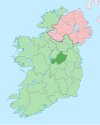Castletown Geoghegan
Castletown Geoghegan
Baile Chaisleáin Mag Eochagán | |
|---|---|
Village | |
IST (WEST)) | |
| Irish Grid Reference | N337442 |
Castletown Geoghegan (Irish: Baile Chaisleáin Mag Eochagán)[2] is a village in County Westmeath, Ireland, and lies south west of Lough Ennell near the county town of Mullingar. It is around 13 km south-west of Mullingar and 19 km north of Tullamore. Castletown was the seat of the Geoghegan family of the medieval Barony of Moycashel in County Westmeath.
History

The Mac Eochagáin family are descended from Fiacha, son of Niall Naoi Noigíallach. Niall is reputed to have captured and enslaved the teenage Magnus Succetus - who later returned to preach Christianity as Patricius - in a raid on the Cumbrian or Welsh coast. The descendants of Niall's son Fiacha (Fiachu Fiachrach) were collectively known as Cenel Fhiachaigh, of the southern Ui Neill (later anglicised as Kenaleagh and Kindalane).[citation needed]
The Geoghegan family were major landholders in south Westmeath and maintained a peaceful co-existence with the Tudor reconquest through a process known as "surrender and regrant". As the reign of the Stuarts led to the
In the general political reform, following the Tudor Conquest, the somewhat reduced medieval barony was subject to the "surrender and regrant" process and the adroit Geoghegan family Chief Kedagh complied and was accorded the title of 'Captain' Geoghegan in the reign of Queen Elizabeth I. He resided in the principal Geoghegan castle of the barony which was located in the village at this time.[citation needed]
The Restoration resettlement acts of the late 17th century favoured the retention of land by some of the recently ensconced Cromwellian "adventurers" and "undertakers" and some to their traditional owners. Consequently, some relatively small holdings of the rich grazing lakeland was restored to the Geoghegans. It did not help the case for a greater degree restoration of Geoghegan land that the chieftain Bryan and many of his allies of the "Irish of Meath" coalition refused to sign the mandatory pledges and undertakings of fealty to the new regime of William and Mary, to parliament and to the established church. The Geoghegan leaders, along with many more native landholders, mostly headed for exile and to Connaught (where some of them reverted to their patronymic surname of O'Neill).[citation needed]
The Geoghegan family had led a group of local Gaelic chieftains in a long-term alliance. The 'Irish of Meath' included the O'Melaghlin (
The Abbé
The surrounding territories were held by the
Built heritage
The local graveyard, in the townland of Castletown, contains gravestones mainly dating from the 18th to the early-20th centuries and is on the site of a ruined medieval churchyard.[4]
Middleton Park House, a country house built c. 1850, is located near Castletown Geoghegan.[5] Also in the area is Mount Druid, an alternative wedding venue.[6]
Sport

The 1946 Epsom Derby winner, Airborne was bred near the village in 1943.[7]
People
People associated with Castletown Geoghegan include:
- Dermot Farrell, Archbishop of Dublin, born in the town;
- George Boyd-Rochfort, VC, buried in Castletown Old Churchyard;
- Alan Mangan, Gaelic footballer, from Castletown Geoghegan.[8]
See also
References
- ^ "Sapmap Area - Settlements - Castletown Geoghegan". Census 2016. Central Statistics Office. April 2016. Retrieved 16 March 2020.
- ^ "Baile Chaisleáin Mag Eochagán/Castletown Geoghegan". Placenames Database of Ireland. Government of Ireland. Retrieved 25 June 2011.
- ^ "Geoghegan Family". irishmidlandsancestry.com. Archived from the original on 18 February 2007.
- ^ "Castletown, Castletown Geoghegan, Westmeath". Buildings of Ireland. Retrieved 24 January 2024.
- ^ "Middleton Park House, Kilhugh, Castletown Geoghegan, Westmeath". Buildings of Ireland. Retrieved 24 January 2024.
- ^ "Mount Druid ⋆ Alternative Wedding Venue @ Mount Druid". Alternative Wedding Venue @ Mount Druid. Retrieved 24 January 2024.
- ^ Armytage, Marcus (31 March 2011). "Oscar Time primed for his chance in the Grand National spotlight". London: Telegraph. Retrieved 12 November 2011.
- ^ "Mangan 'up to the challenge' of retaining Labour seat". Westmeath Examiner. 6 July 2018.
External links
- Geoghegan Clan Archived 29 August 2014 at the Wayback Machine
- Niall of the Nine Hostages

